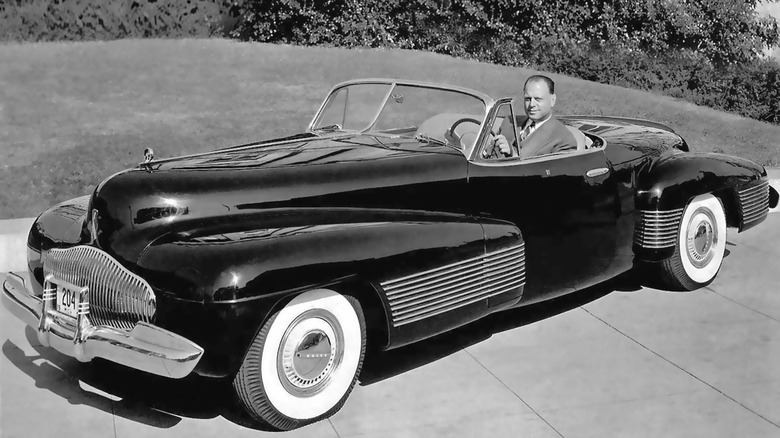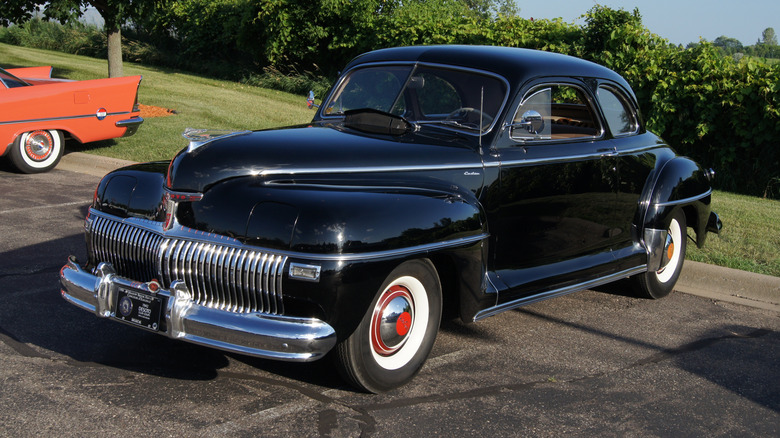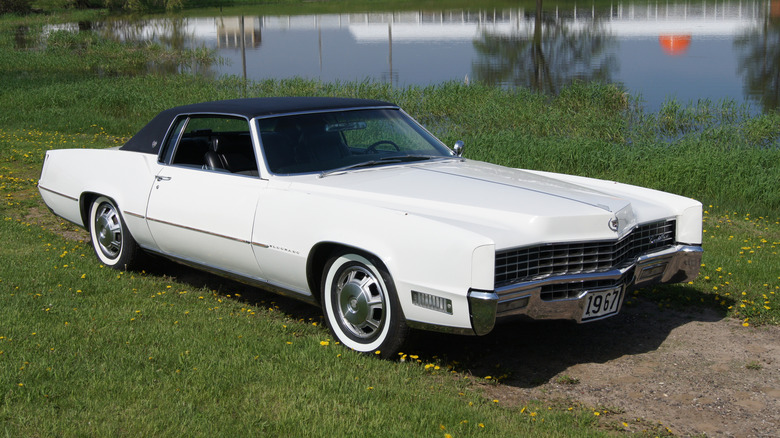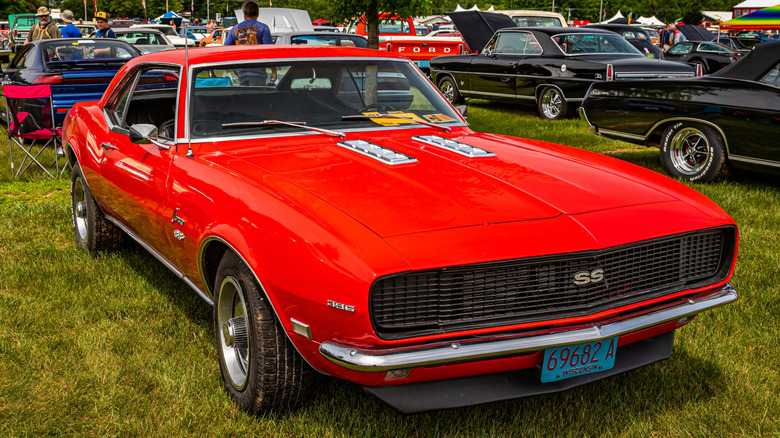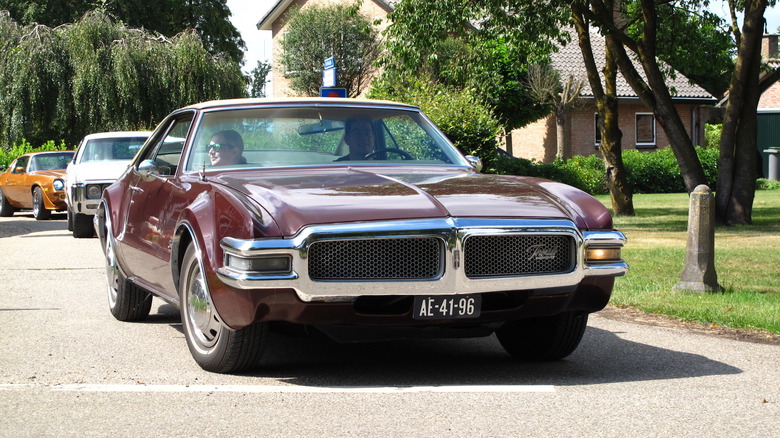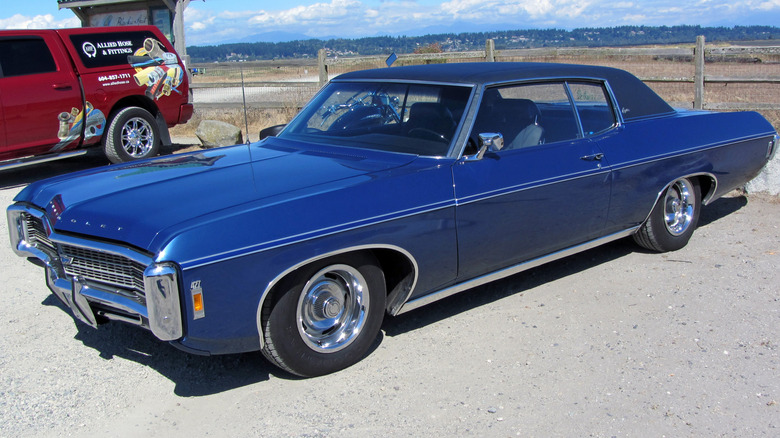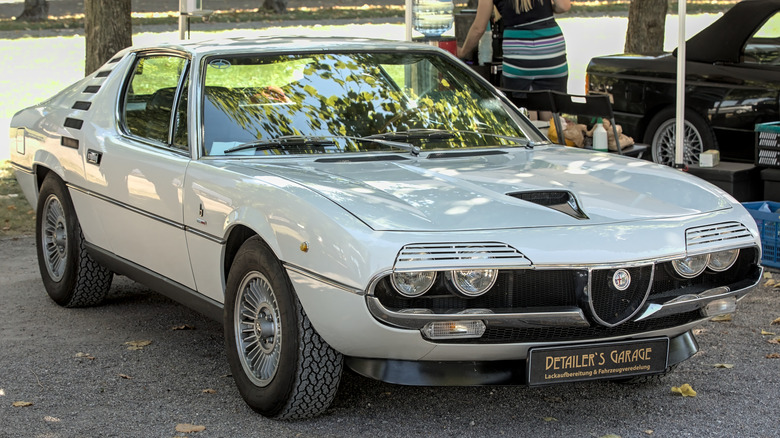10 Seriously Cool Classic Cars With Hidden Headlights
Today's car designers have it made when designing car headlights. Modern LED lights allow a wide variety of shapes, including angry glaring eyes, cat-like squints, boomerang shapes that would be right at home on the Batmobile, and alien-looking headlight-and-light bar combos. They have so many more options than designers in the past, who started out with headlights that were originally lamps fueled by oil or acetylene. By the early 1940s, headlights had been standardized across the industry into round, sealed-beam lights, which were great for safety and for car owners who wanted to be able to buy replacement lights anywhere. However, they left designers with few options for creating an individualized style for each car model.
One way to keep the front of a car from looking like all the other cars on the road was to hide the headlights when they weren't in use. In recent decades, some of the coolest cars had pop-up headlights, but designers have been finding ways to hide lights discreetly since the 1930s. This could improve aerodynamics, allowing cars to go faster on the track during the day and still be driven home at night. In other cases, designers wanted to create stunningly beautiful cars without being handcuffed by the need to integrate visible lights into the front. Hiding headlights has become a lost art in the LED age, but some classic cars have headlights worthy of a place in museums for their clever design and engineering.
1936-1937 Cord 810 and 812
The Cord 810, later called the 812, was a vehicle decades ahead of its time. This low-slung, streamlined beauty featured front-wheel drive and other technologies that previewed the future — including hidden headlights. Like other cars of its era, the lights were on the pontoon-like front fenders. When retracted, they helped give the car an uncluttered, aerodynamic appearance. To open them, the driver turned a pair of cranks at either end of the instrument panel, which was itself a high-tech wonder for its era. Inspired by aircraft cockpits, the aluminum instrument panel featured side-lit, luminous gauges.
The rest of the car was a study in cutting-edge engineering. Its 125 horsepower Lycoming V8 received a supercharger in 1937, boosting it to 195 horsepower and making the Cord 812 one of the fastest pre-war cars in America. Aluminum cylinder heads dissipated heat more efficiently than most other contemporary engines. Even the door hinges received special attention, concealed inside the doors rather than on the exterior as in most other cars of the era. The car's blunt nose received the nickname "coffin-nose," which was an uncharitable name for a very elegant design that included wraparound horizontal trim bands for a look reminiscent of Art Deco designs. While fewer than 3,000 examples of this model were built, the Cord 810 and 812 would influence automotive design trends for decades.
1938 Buick Y-Job
Technically, the Buick Y-Job was what we would call a concept car today. However, it was also chief designer Harley Earl's personal car for several years, so it could almost be considered a road-going car with a production run of one. Like the Cord 810, it would influence automotive design for generations and featured many cutting-edge technologies, namely its headlights, which "blinked" open and closed with upper and lower covers like eyelids. These headlights were power-retractable, giving them a leg up on the hand-cranked retractable headlights in the Cord.
Numerous other features placed the Y-Job among classic concept cars ahead of their time. Its overall style was longer and lower than the more upright production cars of its era, with flush door handles, wraparound bumpers, and recessed taillights to complement the hidden headlights. These are all design features that are common today. It was the first car with power windows, and its revolutionary convertible roof disappeared beneath a metal deck — also a first. The Y-Job also pioneered power steering. Its vertical grille became a Buick signature that's still in use today. Even the car's name is futuristic, inspired by the use of the X designation in aircraft prototypes, but going one further by using the letter Y.
1942 DeSoto
While the 1942 DeSoto was not the first car to feature hidden headlamps, the vehicle is often credited with being the first mass-market production car with that feature. Chrysler's DeSoto division referred to its design as Airfoil Lights, and they were operated by a push/pull handle under the dashboard. When actuated, the covers popped open, but the headlights remained stationary. The switch to turn on the lights was integrated into the handle. The lights were sealed-beam headlamps, as these had become the standard across the auto industry by the time the DeSoto debuted. DeSoto's marketing materials referred to its hidden headlights as "out of sight, except at night."
The United States' entry into the Second World War interrupted production of the 1942 DeSoto, and when the company resumed building cars after the war, the hidden lights were no longer a feature. DeSoto remained a cutting-edge car manufacturer, being among the first to feature such modern conveniences as air conditioning and a semi-automatic transmission. It also offered an innovative Personalized Interiors program, which allowed customers to choose from 10 interior trim combinations. Its styling was often portrayed as sleek and aerodynamic for its time, too. As the years went by, DeSotos became available with Hemi engines, but by the late 1950s, DeSoto was in a downward spiral of declining sales. Chrysler shuttered the division in 1961.
1965 and 1966-69 Buick Riviera
In the early to mid-1960s, the Buick Riviera was GM's answer to the Thunderbird and helped create the category of the personal luxury coupe. As such, style was a key element to the Riv's success. Although the car featured conventional exposed headlights for its first two model years in 1963 and 1964, for 1965, Buick's designers introduced clamshell covers that hid the headlights to create a wild and futuristic look when they were closed. These have made the 1965 model the favorite among collectors seeking a first-generation Riviera. Behind the covers, the car featured four conventional lights stacked in two vertical pairs, but with the covers closed, the dramatic, forward-leaning front end seemed to scoff at the idea that night would ever fall.
The Riviera was redesigned for its second generation in 1966, and while the headlight design changed, the lights still stayed out of sight while the sun was shining. Come nighttime, however, a flick of the headlight switch would make the headlights drop down from their hiding place under the leading edge of the hood, giving the Riv a conventional-looking horizontal quad headlight setup inboard of the parking lights. Like many cars with hidden headlights, it sacrificed nighttime aesthetics for a stunning appearance when the headlights were shut off. The redesigned headlights complemented a restyled body and the 340 horsepower, 425-cubic-inch V8 to create another instant classic Riviera.
1967-1968 Cadillac Eldorado
By the late 1960s, GM's standard-bearer in the personal luxury coupe category was the Cadillac Eldorado, which was also the first Caddy with hidden headlights. Eldorado models had existed for years, but for 1967, it was redesigned to share the same platform as the Riviera and the Oldsmobile Toronado, although with an angular, knife-edged, tail-finned style that set it apart from its less expensive platform mates. In front, retractable covers exposed a horizontal row of quad headlights similar to those in the 1966 and 1967 Riviera, but unlike the Buick, the headlights themselves didn't move.
The Eldorado had several other unusual design features that set it apart from its GM cousins. For instance, its C-pillars were so wide that when the rear quarter windows were opened, they slid backward into the pillar rather than down. The hood featured a huge bulge that tapered toward the nose, as the Eldorado had been considered for an enormous V12 or V16 engine. Ultimately, the Eldo ended up with Cadillac's proprietary 429-cubic-inch V8 producing 340 horsepower. The 1967 Eldorado was front-wheel-drive, like the Toronado, although the Riviera that shared the same platform with both of these cars remained rear-wheel-drive. The new Eldorado was a huge sales success, tripling its sales numbers over the 1966 model.
1967-1969 Chevrolet Camaro
The runaway success of the Ford Mustang led Chevy to march into the pony car wars with the 1967 Camaro. The Camaro's rushed development led to numerous issues such as a rear end that tended to bottom out, but Chevy's designers hit it out of the park with the Camaro's styling. This included a Rally Sport (RS) package with hidden headlights. The RS headlights resided behind covers that exposed the fixed-position lights by rolling inwards toward the grille. In 1969, the opaque headlight covers were replaced with units with glass slots that allowed light to shine through even if the doors failed to open. The RS's headlights complemented the Camaro's chiseled-looking body and muscular haunches to land the 1967 Camaro RS on our list of the best-looking Camaro models of all time.
The Camaro offered more than good looks. A range of V6 and V8 engines included a pair of big-block 396-cubic-inch V8 engines producing 325 and 350 horsepower. Buyers could personalize their Camaros with the RS package's hidden headlights, various interior options, and multiple transmission choices. The extensive options included performance upgrades like disc brakes, quick-ratio steering, and numerous axle ratios. A convertible model was offered, along with the hardtop coupe. Despite the Camaro's rough edges, Chevy sold 220,000 in 1967 and 235,147 in 1968, proving that Chevy had found a winning formula.
1968-1969 Oldsmobile Toronado
The original 1966 Toronado broke new ground as a member of GM's personal luxury coupe trio along with the 1966 Riviera and the 1967 Eldorado. When the Toronado was introduced, winning Motor Trend's Car of the Year award, it featured pop-up headlights that are familiar from recent decades on cars ranging from the Mazda Miata to the Lamborghini Countach. But when Oldsmobile gave the Toronado a facelift for 1968, it changed the headlights radically. Now the headlights were mounted to the grille, and when they were turned off, the entire grille rotated upwards under the hood. In its place, another lightless grille rolled up to replace it.
This created a very distinctive front end that no doubt left many bystanders wondering where the headlights were. In most cars with hidden headlights, there's at least an outline of where the lights are hidden if you look closely enough. The Toronado looked as if it didn't have any headlights at all — until the switch was flipped, and the hidden grille rolled down from under the hood. It was unusual but attention-grabbing. With a 400-horsepower V8 that also produced a thunderous 500 lb-ft of torque, it had more than enough power to back up its exotic looks. This gave the 1968 Toronado all the makings of an instant classic.
1968-1969 Chevrolet Caprice
Chevy models like the Impala, the Chevelle SS, and the Camaro got much of the attention during the muscle car era, but the Caprice is one of Chevy's most underappreciated muscle cars. With a range of V8 engines producing up to 425 horsepower, the Caprice was a legitimate performance car. For 1968 and 1969, Caprice buyers could give their cars a visual upgrade, too, by checking off a $79 option for hidden headlights. Turning on the lights would make a retractable cover roll up under the hood, exposing the Caprice's horizontally arranged quad headlights. With the lights off and covered, the car appeared to have an unbroken grille stretching between the side marker lights, giving the somewhat chunky Caprice a smoother and sleeker look.
The Caprice began life as an upmarket Impala in 1965 before becoming its own model line the following year. It was available as a sedan, a hardtop coupe, and a station wagon. It was successful, with 210,515 units sold, about half of which were coupes. In 1968, the Caprice offered a special coupe featuring distinctive side molding and wheel covers to create a look that was often compared to Cadillacs. The hidden headlights could be ordered to complete the luxury coupe look.
1970-1977 Alfa Romeo Montreal
The stunning Alfa Romeo Montreal could be one of the most criminally underrated car designs of its era. It's certainly one of the best Alfa Romeos of all time. Aerodynamics shaped the Montreal as much as beauty, with retractable louvered "eyelids" half-concealing its headlights for lower drag. The louvers retracted when the headlights were turned on, sweeping down in front of the headlights and then underneath them and out of sight, but when they were visible, they gave the Montreal's front end an extra hint of aggression. The Montreal borrowed the V8 engine from Alfa's mid-engined, race-inspired Tipo 33 Stradale. The engine featured an aluminum block, an advanced mechanical fuel injection system, dual overhead camshafts, and 16 valves. In the Montreal, it was paired with a five-speed manual transmission.
It all added up to a 0-60 mph time of just a tick over seven seconds and a 137 mph top speed. A sophisticated suspension, four-wheel ventilated disc brakes, and a limited-slip differential imparted terrific handling. Yet the oil crisis of the 1970s dampened demand for V8-powered sports coupes and Alfa made just 4,000 units during its eight-year production run. Its rarity combines with its excellent performance and stunning looks to make it highly desirable among collectors today.
2022+ Ferrari Daytona SP3
New cars don't have pop-up headlights largely because of European safety regulations. Luckily, today's LED lighting systems give car designers plenty of alternatives. The limited-edition Ferrari Daytona SP3 partially hides its squinting LED headlights behind retractable hoods. This gives it the best of both worlds since it matches modern lighting with slippery aerodynamics. Every inch of this extra-special Ferrari has been sculpted to combine modern aerodynamics with the styling cues of classic Ferraris. It uses clever aero tricks to generate 500 pounds of downforce without using active aerodynamic devices like adjustable front or rear spoilers. The car's incredible shape does all the work.
The Ferrari Daytona SP3 is a limited-edition targa that's a technical tour de force from the engineers in Maranello. As an example, it offers an active front suspension that lifts the nose so the front chin spoiler clears speed bumps. These are thoughtful touches you might expect in a $2.2 million car. You'll also get the thrill of hearing an 828-horsepower V12 screaming up to the 9,500-rpm redline right behind your ears as this mid-engine missile flies to a top speed of 211 mph, passing 62 mph along the way in only 2.85 seconds. Every component has been engineered for light weight and speed, such as titanium connecting rods that weigh 40% less than steel rods.


